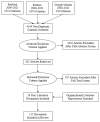Exploring and Monitoring Privacy, Confidentiality, and Provider Bias in Sexual and Reproductive Health Service Provision to Young People: A Narrative Review
- PMID: 35682160
- PMCID: PMC9180733
- DOI: 10.3390/ijerph19116576
Exploring and Monitoring Privacy, Confidentiality, and Provider Bias in Sexual and Reproductive Health Service Provision to Young People: A Narrative Review
Abstract
Purpose: Poor privacy and confidentiality practices and provider bias are believed to compromise adolescent and young adult sexual and reproductive health service quality. The results of focus group discussions with global youth leaders and sexual and reproductive health implementing organizations indicated that poor privacy and confidentiality practices and provider bias serve as key barriers to care access for the youth.
Methods: A narrative review was conducted to describe how poor privacy and confidentiality practices and provider bias impose barriers on young people seeking sexual and reproductive health services and to examine how point of service evaluations have assessed these factors.
Results: 4544 peer-reviewed publications were screened, of which 95 met the inclusion criteria. To these articles, another 16 grey literature documents were included, resulting in a total of 111 documents included in the review.
Conclusion: Poor privacy and confidentiality practices and provider bias represent significant barriers for young people seeking sexual and reproductive health services across diverse geographic and sociocultural contexts. The authors found that present evaluation methods do not appropriately account for the importance of these factors and that new performance improvement indicators are needed.
Keywords: confidentiality; developing countries; privacy; provider bias; reproductive health services; young people.
Conflict of interest statement
The authors declare that they have no competing interests.
Figures


Similar articles
-
"Be kind to young people so they feel at home": a qualitative study of adolescents' and service providers' perceptions of youth-friendly sexual and reproductive health services in Vanuatu.BMC Health Serv Res. 2013 Oct 31;13:455. doi: 10.1186/1472-6963-13-455. BMC Health Serv Res. 2013. PMID: 24176059 Free PMC article.
-
Barriers to sexual reproductive health services and rights among young people in Mtwara district, Tanzania: a qualitative study.Pan Afr Med J. 2012;13 Suppl 1(Suppl 1):13. Epub 2012 Dec 26. Pan Afr Med J. 2012. PMID: 23467684 Free PMC article.
-
Barriers and enablers to young people accessing sexual and reproductive health services in Pacific Island Countries and Territories: A scoping review.PLoS One. 2023 Jan 26;18(1):e0280667. doi: 10.1371/journal.pone.0280667. eCollection 2023. PLoS One. 2023. PMID: 36701390 Free PMC article.
-
A 'mystery client' evaluation of adolescent sexual and reproductive health services in health facilities from two regions in Tanzania.PLoS One. 2015 Mar 24;10(3):e0120822. doi: 10.1371/journal.pone.0120822. eCollection 2015. PLoS One. 2015. PMID: 25803689 Free PMC article.
-
Human rights and the sexual and reproductive health of women living with HIV--a literature review.J Int AIDS Soc. 2015 Dec 1;18(Suppl 5):20290. doi: 10.7448/IAS.18.6.20290. eCollection 2015. J Int AIDS Soc. 2015. PMID: 26643461 Free PMC article. Review.
Cited by
-
Community perspectives on family planning service quality among users and non-users: a qualitative study from two cities in Burkina Faso.Reprod Health. 2023 May 17;20(1):75. doi: 10.1186/s12978-023-01618-8. Reprod Health. 2023. PMID: 37198684 Free PMC article.
-
Utilization of sexual and reproductive health services among young people in refugee settings in Uganda.Front Reprod Health. 2023 Feb 24;5:1077761. doi: 10.3389/frph.2023.1077761. eCollection 2023. Front Reprod Health. 2023. PMID: 36910338 Free PMC article.
-
Utilization of family planning and associated factors among women with disabilities in ethiopia: A systematic review and meta-analysis.PLoS One. 2023 Sep 8;18(9):e0291189. doi: 10.1371/journal.pone.0291189. eCollection 2023. PLoS One. 2023. PMID: 37683008 Free PMC article.
-
Utilization of social franchising in family planning services: a Pakistan perspective.Front Glob Womens Health. 2024 May 17;5:1376374. doi: 10.3389/fgwh.2024.1376374. eCollection 2024. Front Glob Womens Health. 2024. PMID: 38826760 Free PMC article.
-
Comparing youth-friendly clinics to the standard of care for adolescent girls and young women in Malawi: A qualitative analysis.Glob Public Health. 2025 Dec;20(1):2481466. doi: 10.1080/17441692.2025.2481466. Epub 2025 Mar 26. Glob Public Health. 2025. PMID: 40138518
References
-
- Sully E., Biddlecom A., Darroch J.E., Riley T., Ashford L.S., Lince-Deroche N., Firestein L., Murro R. Adding It Up: Investing in Sexual Andss Reproductive Health 2019. Guttmacher Institute; New York, NY, USA: 2020. - DOI
-
- Centers for Disease Control and Prevention . Sexually Transmitted Disease Surveillance 2014. U.S. Department of Health and Human Services; Atlanta, GA, USA: 2015.
-
- World Health Organization . Global Health Estimates 2015: Deaths by Cause, Age, Sex, by Country and by Region, 2000–2015. WHO; Geneva, Switzerland: 2015.
Publication types
MeSH terms
LinkOut - more resources
Full Text Sources
Miscellaneous

